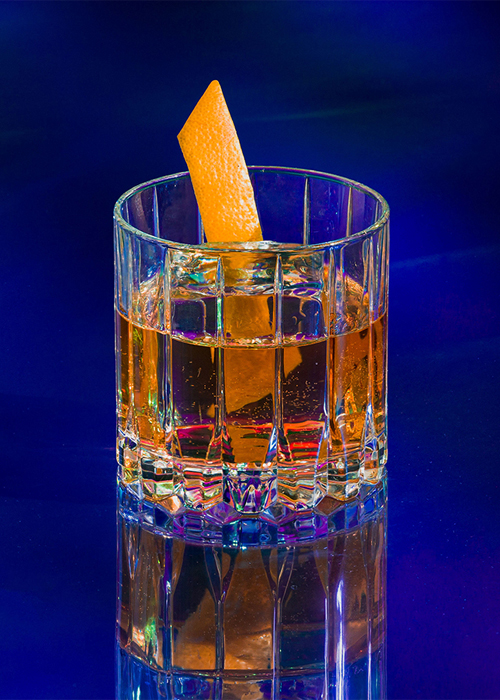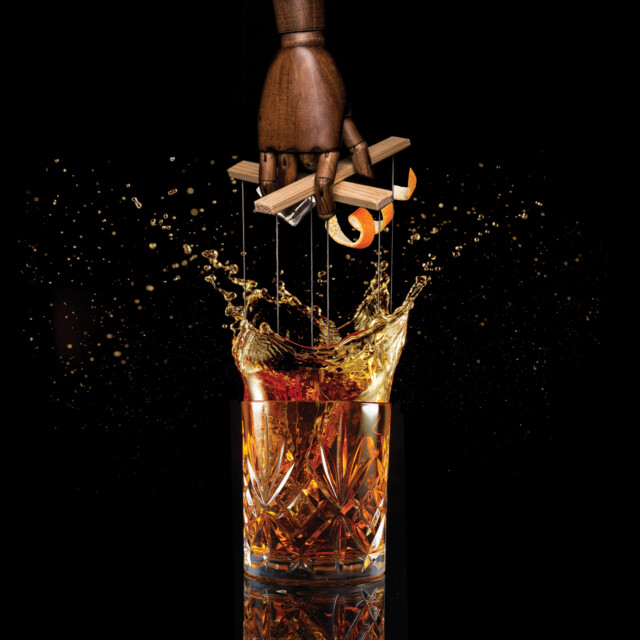The Paramount+ miniseries “The Offer” — inspired by producer Albert S. Ruddy’s stories of the chaotic behind-the-scenes making of “The Godfather,” the 1972 film adaptation of Mario Puzo’s bestselling novel — can, at best, be called a guilty pleasure (though English actor Matthew Goode thoroughly steals the show with his portrayal of legendary Hollywood producer Robert Evans).
During a wrap party scene set at a dark Italian restaurant on Mulberry Street, Marlon Brando (played by Justin Chambers) approaches the bar and mumbles, “You, uh… you got Disaronno?” When the bartender nods, Brando requests “equal parts Disaronno and Scotch on ice.” The bartender hands him the drink and asks, “What do you call that?” Brando’s response: “A delivery system.”
This blink-and-you’ll-miss-it Easter egg leans into the apocryphal origin story that the two-ingredient Scotch and amaretto cocktail known as the Godfather was a favorite drink of Brando (something that Disaronno never actually purported to be true, nor outright denied). It’s more likely the early ’70s drink was named after the movie itself, especially as it featured an Italian-born ingredient in amaretto, and Scotch was frequently seen in the film during meetings in Vito Corleone’s office and during strategic sit-downs.

The equal-parts nature of the Godfather — a duo cocktail, like a Stinger or Rusty Nail, made up of a spirit plus liqueur — eventually shifted to a two-to-one blend of Scotch to amaretto that helped cut down the inherent sweetness of the drink. And like the movie, the Godfather spawned its own extended family of sequels, including the Godmother (vodka and amaretto), the Goddaughter (vodka, amaretto, and cream), the Godson (Scotch, amaretto, and cream), Godchild (brandy and amaretto), and the Brooklyn Godfather (bourbon, amaretto, sweet and dry vermouth). Yet even though drinks like the Cosmopolitan, the Grasshopper, and the Espresso Martini have been embraced by a new generation of drinkers, the Godfather seemed destined to remain a footnote, a nostalgic holdout of darkened dive bars and dusty, after-dinner drink menus at old-school red-sauce joints.
The Godfather Gets a Makeover
“The Disco Era of cocktails tends to get a bad rap, and rightfully so. A lot of bad things came out of that time in history,” says Nicholas Bennett, beverage director at Porchlight in Manhattan. “The Godfather is often lumped in, but I don’t think it deserves it.” Bennett is drawn to the after-dinner appeal of the drink, especially on a cold night, but he recommends treating it like an Old Fashioned, using a quality blended Scotch and cutting the amaretto to a half-ounce. “We have decades of experience under our belt now and to let a cocktail as easy, popular, and tasty as a Godfather be overlooked is a sin,” says Bennett.
But can a drink as dated as a 1970s leisure suit, with a reputation of being unbalanced, too sweet, and not all that interesting, survive a makeover that appeals to contemporary tastes while still respecting its heritage? In the past decade, several updates on the Godfather gained traction, including the Godfather II (a blend of bourbon and single-malt Scotch with amaretto, Angostura bitters, and a housemade sarsaparilla tincture), created by Tyler Caffall at Fort Defiance in Red Hook, Brooklyn, and Godfather No. 2 (blended Scotch and amaretto bolstered with amontillado sherry, maraschino liqueur, Angostura bitters, and two dashes of single-malt Scotch) at Tosca Café in San Francisco’s North Beach neighborhood. Based on the popularity of Godfather variations as a dealer’s choice among bartenders and the number of new-look takes that will warm you up as we head into winter, now may be the right time to reconsider the Godfather.
Leaning Into the Spirited Nature of the Godfather
Two recent Godfather tributes each turn to the Sazerac for inspiration, honoring the original’s spirit-forward profile while both complementing and countering the marzipan and cherry notes of amaretto with layered bitter liqueurs. The Godfather at Maialino (vicino), the Roman-inspired trattoria and wine bar in New York’s NoMad neighborhood, is composed of Chivas Regal 13-year blended Scotch that’s been aged in oloroso sherry casks, Lazzaroni amaretto, and Fred Jerbis Bitter, a small-batch, unfiltered amaro from Friuli, and garnished with a cherry.
“As envisioned, the original Godfather is just ridiculously sweet,” says Patrick Smith, the director of bar openings for the Union Square Hospitality Group. “This feels like it should be an old-school drink and Chivas definitely has that grandfather vibe.” Smith found that adding the all-natural Fred Jerbis bitter helped make it a more three-dimensional drink and presented a “more grown-up” serve. For Maialino beverage director Cory Holt, the Godfather’s strong but approachable nature helps it play dual roles as a first cocktail of the evening as well as an after-dinner drink. “The Godfather was never a mass-consumption drink to begin with, really,” says Holt. “It’s a strong and heavy drink, and sweetness can add a cloyingness rather than balance. …You have to use quality ingredients to keep the drink feeling balanced.”
When Brooklyn bar Grand Army recently updated its seasonal cocktail list, the first drink the team locked down for their game shows-themed fall/winter menu was a Godfather-meets-Sazerac hybrid called The Price Is Right. It was a French Connection, yet another Godfather variation made with Cognac and amaretto, that inspired bartender Shannan Lynch to experiment with multiple spirit-amaretto combinations.

She loved the combination of Calvados with a split modifier of Lazzaroni amaretto and Vicario nocino walnut liqueur. During additional R&D, the team considered adding Scotch back into the mix but ultimately settled on partnering Avallen Calvados with Michter’s Rye, which added a bit of apple and spice. “I think people have strayed away from ordering a Godfather because it tends to be sweeter, but also it’s possible that a lot of people aren’t familiar with it, period,” says Grand Army beverage director Ally Marrone. “But The Price Is Right has been selling especially well on cold nights when the fireplace is roaring at the bar.”
The Godfather Goes to the Mattresses
Matt Reysen’s personal experience with the Godfather was making them in droves during his first year of bartending at an old-school, fine-dining restaurant. But as the bar director for Mel’s and Al Coro in New York’s Meatpacking District, he thought the disco-era drink deserved a makeover at their basement cocktail club, Discolo.
His complex Godfather 2 plays off the nutty characteristics of a classic Godfather but does so without a drop of amaretto. A split base of Rémy Martin 1738 Cognac and Glenlivet 12 single-malt Scotch are stirred together with a housemade Tiger fig syrup, Marco de Bartoli Marsala wine, a small amount of Nardini Mandorla grappa (“It’s a double-distilled grappa blend infused with almond oil, which is highly aromatic,” says Reysen. “A little goes a long way.”), along with a finishing touch of saline, Tempus Fugit Crème de Banane, and chocolate bitters.
For The Pat Geary at Brooklyn’s The Rockwell Place, general manager and head bartender Alex Kveton turned to the Rolodex of Godfather characters for inspiration, landing on the corrupt United States Senator from Nevada in “The Godfather: Part II.”
The Pat Geary calls for Compass Box Glasgow Blend Scotch, Luxardo Amaretto di Saschira (a favorite of Rockwell Place co-owner Toby Cecchini), Cocchi Dopo Teatro vermouth amaro, and Angostura bitters. But Cecchini’s suggestion of adding Cynar was key in modernizing the cocktail. “There is a perceived sweet essence from the amaretto, but there’s big flavor up front but because of the rhubarb character of the Dopo Teatro and the bitter licorice notes of Cynar,” says Kveton. “It’s a way to make an older cocktail more accessible to folks who aren’t familiar with it. I would not be surprised if the Godfather finds a second wind.”
The Godfather: A Coda
It makes sense that many of these updated Godfather drinks are taking hold in New York, the primary setting for the original film, but just as the Corleone family moved west, so too has the Godfather cocktail.
At Seattle restaurant Damn the Weather, the Godfather is presented among the craft cocktails on the menu under its original name but with subtle, elevating alterations. Owner Bryn Lumsden uses an ounce and a half of Famous Grouse Smoky Black Scotch and a half-ounce of Lazzaroni amaretto (“no other amaretto will do,” he says), built in a double Old Fashioned glass finished with a spritz of lemon oil and two brandied cherries.
“Although these duo drinks tend to be a little sweet in the absence of bitters, I think they hit the spot as a nightcap,” says Lumsden, who lists their Godfather in the “after dinner” section of the menu to signal this isn’t as balanced as an Old Fashioned or Sazerac. “Many guests pass on this drink, but it’s an Easter egg for those drawn to ’70s drinks and also to those who might be curious about cocktails with a ‘less-rather-than-more’ approach. We sell it for a couple dollars less than the rest, to create context for what it is and what it isn’t.”

Sarah Block, the bar manager at J & Tony’s Discount Meats and Negroni Warehouse in San Diego, doesn’t deny that the Godfather is a dated cocktail, primarily because its sole ingredients of Scotch and amaretto make the drink slightly less approachable to most people, but is among a new generation of bartenders who are trying to help it make a comeback. “The Godfather doesn’t scare me off,” says Block, who admits she has a bit of a sweet tooth. “I love the nuttiness of amaretto and I think it pairs well with Scotch, though I’ll typically split my base with bourbon to tone it down a little.”
While the Godfather isn’t on the menu at J & Tony’s, it’s become Block’s go-to dealer’s choice recommendation for those looking for an Old Fashioned riff. Once she gauges a guest’s feelings about Scotch and amaretto she can tailor a Godfather to their liking, from scaling back the amaretto or splitting the base spirits, to adding a few dashes of bitters. “Even within the simple build, there are ways to adjust to each individual palate. I also think the simplicity of it makes it more accessible and I think that resonates with a lot of people,” she says. “The Godfather is a sleeper cocktail for sure, but I’m not giving up hope that it’ll have a resurgence.”
